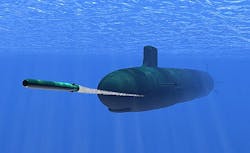High-performance embedded computing could be crucial enabler of bistatic radar and sonar
These offboard transmitters could create a new generation of bistatic radar and sonar that not only could enhance the performance of these systems, but also could preserve the stealthiness of weapons platforms like jet fighter aircraft and fast attack submarines.
Radar and sonar, in their essence, represent relatively simple concepts: they both transmit energy that bounces off objects nearby and detects targets by receiving energy from the return signals. Radar bounces radio waves off targets, while sonar does the same with sound waves.
An added benefit of radar and sonar is the ability to estimate the target's distance from the transmitter, based on the time it takes for the transmitted signal to bounce back. They detect potential enemies and give reasonably accurate estimates of how far away the enemies might be.
Related: DARPA eyes bistatic sonar with UUV-based pingers to preserve stealth of attack submarines
The problem with conventional radar and sonar systems, however, is their lack of stealth; any adversary in the vicinity knows someone's looking for him when he detects the radio emissions of radar systems or the sound emissions of sonar. It's a lot like turning on a flashlight in a darkened room; you can see things easily, but the world knows you're there.
Now take a moment to consider radar and sonar transmitters that are in different locations from their receivers. A detected enemy aircraft would be certain of the presence of a radar-transmitting aircraft, but a receive-only aircraft nearby would remain concealed.
A receiving aircraft, based on radar return signals, could calculate a firing solution and launch air-to-air missiles before the enemy aircraft even knew he was there.
It could be the same scenario for attack submarines. An submerged adversary only would know of a sonar-transmitting submarine, while a receiving submarine would remain concealed and could ready a sudden torpedo attack from an unanticipated direction.
Related: Stealth-detecting bistatic radar is back in the news
Now let's consider a different approach. What if an attack aircraft could launch an unmanned aerial vehicle (UAV) with a radar transmitter on board, while the host aircraft kept his own radar and other electronics quiet? It could add a new dimension to the fight and create a fast-moving triangulating game of cat-and-mouse that could put adversaries in a big disadvantage at a crucial moment.
Apply the same idea to an attack submarine. That vessel could launch a torpedo-shaped unmanned underwater vehicle (UUV) with a sonar transmitter, detect and range enemy submarines in the area, and enable the quiet attack submarine to calculate a firing solution.
This submarine-and-UUV scenario is exactly what the U.S. Defense Advanced Research Projects Agency (DARPA) is working on with the Mobile Offboard Command and Control and Approach (MOCCA) program, which was announced this week. It would involve a quiet attack submarine with an active-sonar-pinging UUV wingman.
The notion of bistatic radar and sonar sounds almost too good to be true, but there's a reason it hasn't caught on in a big way: signal processing. While conventional systems involve just two points -- transmitter/receiver and target -- the bistatic approach adds a third point -- transmitter, target, and receiver.
This third point in the surveillance chain complicates the sonar signal processing challenge, and adds difficulties of time lag, potential uncertainty of the relative positions of transmitter and receiver, and a host of other factors that would require sonar systems with supercomputer-like power.
Such challenges, however, may be getting a solution with today's high-performance embedded computing (HPEC) technology. Embedded versions of the Intel Xeon processor, as well as other high-performance processors, could provide that kind of supercomputer power to deployed aircraft and submarines, and perhaps even new generations of UAVs and UUVs.
It's yet another way to consider the kinds of military capabilities that the latest generations of embedded computing will bring to the table.


